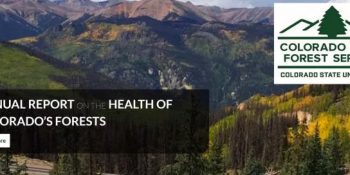FORT COLLINS, Colo. – January 15, 2019 – Bark beetle outbreaks have continued to expand in parts of Colorado, based on a 2018 aerial forest health survey conducted by the Colorado State Forest Service and U.S. Forest Service, Rocky Mountain Region. Every year the agencies work together to aerially monitor forest health conditions on millions of forested acres across the state.
Spruce beetle populations caused widespread tree mortality for the seventh consecutive year. Although the acreage affected by this pest annually has declined for the past four years, 178,000 acres of high-elevation Engelmann spruce were affected statewide in 2018. Approximately one-third of these affected acres were “new,” or previously unaffected areas. Primary areas impacted include forestlands in and around Rocky Mountain National Park, and portions of the San Juan Mountains, West Elk Mountains and Sawatch Range.
Since the year 2000, spruce beetle outbreaks have caused tree mortality on more than 1.8 million acres in Colorado, and approximately 40 percent of the spruce-fir forests in Colorado have now been affected. Blowdown events in Engelmann spruce stands, combined with long-term drought stress, warmer temperatures and extensive amounts of older, densely growing trees, have contributed to this ongoing epidemic.
Another native bark beetle – roundheaded pine beetle, along with associated native bark beetles – has continued to increasingly affect ponderosa pine forests in Dolores County, in southwest Colorado. Over the past several years, populations of this insect have risen exponentially, with 27,000 acres impacted in 2018, compared to 11,000 acres in 2017. Record-warm temperatures and record-low precipitation in southwest Colorado have weakened tree defenses, providing an environmental window that may continue to favor increasing beetle populations.
The aerial survey also revealed that Douglas-fir beetle populations continued to impact low-elevation forests in the central and southern portions of the state, at levels similar to what was observed statewide in 2017. Outbreaks of western spruce budworm declined in 2018, compared to the prior year, although this insect still defoliated 131,000 acres of spruce and fir in the state.
“Colorado’s forests are important to the ecological and economic health of our state,” said Mike Lester, state forester and CSFS director. “Our efforts in partnership with the U.S. Forest Service ensure that we understand the condition of our forests, so we can design the best treatments to enhance forest health.”
Lester says the CSFS is dedicated to providing timely, relevant forestry information to the citizens of Colorado to achieve resilient forests. CSFS publications about spruce beetle, Douglas-fir beetle and many other pests, as well as how private landowners can manage them, are available online at https://csfs.colostate.edu/csfspublications.
To obtain additional information regarding the 2018 Aerial Detection Survey, please contact Dan West, CSFS entomologist, at 970-491-7282. For general information on insect and disease conditions in your local area, please contact the nearest CSFS field office.
***
The Colorado State Forest Service (CSFS) provides professional forestry assistance, wildfire mitigation expertise and outreach and education to help landowners and communities achieve their forest management goals. The CSFS is a service and outreach agency of the Warner College of Natural Resources at Colorado State University and provides staffing for the Division of Forestry within the Colorado Department of Natural Resources. For more information, visit csfs.colostate.edu.
SPREAD THE NEWS
COMMENT, Like, Follow & SHARE @I70Scout
CURRENT EDITION
WEATHER & TRAFFIC PUZZLES RECENT NEWS ADVERTISE WITH US

Leave a Reply